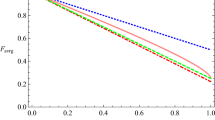Abstract
This paper considers the problem of secure coding design for a type II quantum wiretap channel, where the main channel and the eavesdropper channel are both quantum channel, and the eavesdropper overhears the legitimate communication through a quantum cloning machine. Based on Calderbank-Shor-Steane (CSS)-type quantum low-density parity-check (QLDPC) codes, we show that it is possible to construct linear-time decodable codes for type II quantum wiretap channels to achieve security.


Similar content being viewed by others
References
Wyner, A.D.: The wire-tap channel. Bell Syst. Tech. J. 54(8), 1355–1387 (1975)
Cai, N., Winter, A., Yeung, R.W.: Quantum privacy and quantum wiretap channels. Probl. Inf. Transm. 40(4), 318–336 (2004)
Devetak, I.: The private classical capacity and quantum capacity of a quantum channel. IEEE Trans. Inf. Theory 51(1), 44–55 (2005)
Renes, J.M., Renner, R.: Noisy channel coding via privacy amplification and information reconciliation. IEEE Trans. Inf. Theory 57, 7377–7385 (2011)
Hayashi, M.: Quantum wiretap channel with non-uniform random number and its exponent and equivocation rate of leaked information. IEEE Trans. Inf. Theory 61(10), 5595–5622 (2015)
Wilde, M.M.: Position-based coding and convex splitting for private communication over quantum channels. Quantum Inf. Process. 16, 264 (2017)
Winter, A.: “Pretty strong” converse for the private capacity of degraded quantum wiretap channels. In: IEEE International Symposium on Information Theory. IEEE (2016)
Anshu, A., Hayashi, M., Warsi, N.A.: Secure communication over fully quantum Gel’fand-Pinsker wiretap channel. 1801.00940 (2018)
Calderbank, A.R., Rains, E.M., Shor, P.W., Solane, N.J.A.: Quantum error correction via codes over GF(4). IEEE Trans. Inf. Theory 44(4), 1369–1387 (1998)
Kay, A.: Optimal universal quantum cloning: asymmetries and fidelity measure. Quantum Inf. Comput. 16, 991 (2016)
Roubert, B., Braun, D.: Quantum cloning without interference. Phys. Rev. 78(04), 2311 (2008)
Cernoch, A., Soubusta, J., Celechovska, L., Dusek, M., Fiurasek, J.: Experimental demonstration of optimal universal asymmetric quantum cloning of polarization states of single photons by partial symmetrization. Phys. Rev. A 80(06), 2306 (2009)
Babar, Z., Botsinis, P., Alanis, D., et al.: Construction of quantum LDPC codes from classical row-circulant QC-LDPCs. IEEE Commun. Lett. 20(1), 9–12 (2016)
Hagiwara, M., Imai, H.: Quantum quasi-cyclic LDPC codes. In: IEEE International Symposium on Information Theory (ISIT), pp. 806–811 (2007)
Babar, Z., Botsinis, P., Alanis, D., et al.: Fifteen years of quantum LDPC coding and improved decoding strategies. IEEE Access 3, 2492–2519 (2017)
Harrison, W.K., Almeida, J., Bloch, M.R., et al.: Coding for secrecy: an overview of error-control coding techniques for physical-layer security. IEEE Signal Process. Mag. 30(5), 41–50 (2013)
Harrison, W.K., Almeida, J., Mclaughlin, S.W., et al.: Coding for cryptographic security enhancement using stopping sets. IEEE Trans. Inf. Forensics Secur. 6(3), 575–584 (2011)
Subramanian, A., Thangaraj, A., Bloch, M., et al.: Strong secrecy on the binary erasure wiretap channel using large-girth LDPC codes. IEEE Trans. Inf. Forensics Secur. 6(3), 585–594 (2011)
Orlitsky, A, Viswanathan, K, Zhang, J.: Stopping set distribution of LDPC code ensembles. IEEE Trans. Inf. Theory 51(3), 929–953 (2005)
Acknowledgements
This work was supported by the National Science Foundation of China (NSFC) under grant NO. 61701375, Natural Science Basic Research Plan in Shaanxi Province of China (No. 2016JQ6063), and the Fundamental Research Funds for the central Universities (No. 300102328110).
Author information
Authors and Affiliations
Corresponding author
Rights and permissions
About this article
Cite this article
Xiao, H., Wang, H. Secure Coding for Type II Quantum Wiretap Channel. Int J Theor Phys 57, 3318–3325 (2018). https://doi.org/10.1007/s10773-018-3845-9
Received:
Accepted:
Published:
Issue Date:
DOI: https://doi.org/10.1007/s10773-018-3845-9




